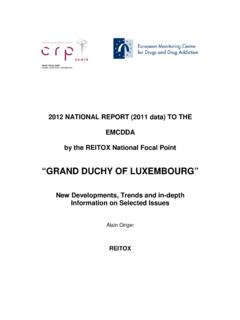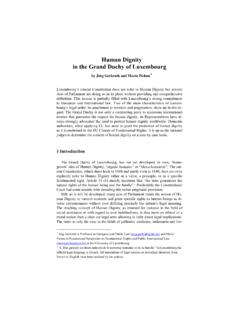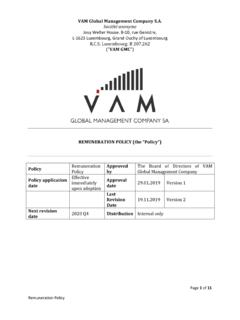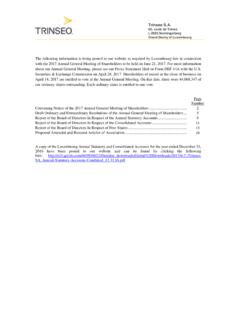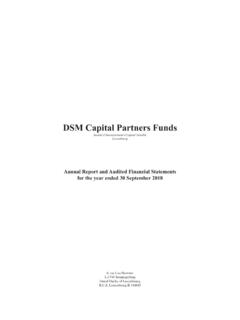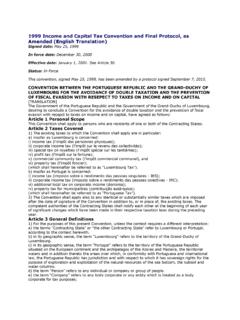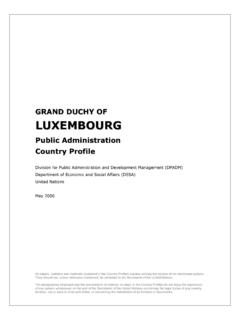Transcription of History of the Grand Duchy of Luxembourg
1 Grand Duchyof LuxembourgForm of government:constitutionalmonarchyNeighbo uringcountries:Germany,Belgium,FranceAre a:2,586 km2 Population:476,000 inhabitants,of which198,000are foreignersPopulation density:184 (2007) origins (10th century)The current geographical and political form of the Grand Duchy is a creation of 19th-century diplomacy. Yet the History behind what is now known as Lux- embourg dates back much further in time. The name Lucilinburhuc, meaning small castle , materialised for the first time in an exchange charter around 963. With this document, Count Siegfried acquired from the abbey of St Maximin in Trier a small fort (castellum quod dicitur Lucilinburhuc) located on the rocky outcrop of the Bock, which dominates the valley of the Alzette.
2 At the time, this territory was part of the western fringe of the Holy Roman its small size 2,586 km2 and home to 476,000 inhabitants the Grand Duchy of Luxembourg is a sovereign state with a rich History . Nestled between France, Belgium and Germany in the heart of Europe, it has been involved in the great European developments. The turbulent past of the Grand Duchy is a true mirror of European History . During the Middle Ages, its princes wore the crown of the Holy Roman Empire. In Early Modern Times, its fortress was a major bone of contention in the battle between the great powers. Before obtaining its independence during the 19th century, Luxembourg lived under successive Burgundian, Spanish, French, Austrian and Dutch sovereignty.
3 During the 20th century, this wealthy and dynamic country acted as a catalyst in the unification of Europe. View of the rocky outcrop called Bock featuring the remains of Lucilinburhuc castle ditions Guy BinsfeldHistory of the Grand Duchy of History of the Grand Duchy of Luxembourg / Information and Press Service of the Luxembourg Government / assembling (11th-13th century)When Siegfried established himself on the Bock, he owned land along the rivers of the Moselle, the S re and the Alzette, as well as in the Ardennes. Neverthe-less, his possessions remained scattered. The County of Luxembourg , as a territorial principality, was a cre-ation of Siegfried s descendants. Conrad I (deceased in 1086) was the first to explicitly bear the title of comes de Luccelemburc.
4 The fortified castle Lucilinburhuc be- came the anchor point from which territorial assem-bling took place during the 11th, 12th and 13th centuries. Territory expansion was achieved through marriages, land purchases, vassalage ties and, above all, through war. The counts of Luxembourg succeeded in defeating their rivals, despite suffering occasional setbacks, such as the Battle of Worringen (1288), during which Count Henry VI and three of his brothers fell, mortally wound- ed. At the end of the 13th century, the County of Luxem-bourg occupied a vast area between the Meuse and the Moselle, with the particularity of straddling the linguistic border, with one part being German-speaking, the other French-speaking.
5 At the head of the Holy Roman Empire (14th-15th century)During the early 14th centur y, the house of Luxembourg acceded to the imperial throne. In 1308, Count Henry VII was elected king of Germany by the prince - electors at the instigation of his brother Baudouin, archbishop of Trier, and by Pierre d Aspelt, archbishop of Mayence, also of Luxembourg origin. A papal legate crowned him emperor in Rome in 1312. His son, John the Blind, married the heiress to the Kingdom of Bohemia and assumed the title of king of Bohemia . A model knight , he died a hero s death in the service of the king of France in the Battle of Cr cy in 1346. Following Henry VII, three further members of the Luxembourg dynasty in succession were to wear the royal or even the imperial crown: Charles IV (1346-1378), Wenceslaus (1376-1400) and Sigismund (1410-1437).
6 In 1354, Charles IV elevated the County of Luxembourg 96296313081310 Creation of the Holy Roman Empire by Otto ICount Siegfried acquires the small fort Lucilinburhuc through an exchange act with the abbey of St Maximin in VII, count of Luxembourg , is elected king of Germany. He is crowned emperor in Rome in the Blind marries Elisabeth, heiress to the Kingdom of Bohemia. The counts of Luxembourg become kings of Bohemia. Stained-glass window of the cathedral of Luxembourg City depicting Count Siegfried ditions Guy History of the Grand Duchy of Luxembourg / Information and Press Service of the Luxembourg Government / the rank of Duchy . It achieved its greatest expansion with the acquisition of the County of Chiny in 1364.
7 Nev-ertheless, with the accession to the royal and imperial rank, the Luxembourgs ended up paying increasingly less heed to their land of origin, which was ceded to lords on mor tgage terms in return for loans, before falling into the hands of the Burgundians. In 1443, Philip the Good, duke of Burgundy, conquered the city of Luxembourg and the Duchy became a province of the Netherlands. Its des-tiny was to be linked to this geographical and political ensemble for the subsequent four province of the Netherlands (15th-18th century)During Early Modern Times, the Netherlands changed sovereignty according to dynastic and political haz-ards. Following the death of Charles the Bold, duke of Burgundy (1477), the Netherlands passed to the Habsburgs.
8 During the 16th and 17th centuries, the Duchy of Luxembourg , along with the other provinces that made up the territory of the Netherlands, belonged to the Spanish Habsburgs. Luxembourg occupied an important strategic position on the European chessboard. From the 16th century onwards, the country was drawn into the numerous wars fought for the hegemony in Europe by the Spanish Habsburgs and the Valois, and finally the Bourbons of Fr ance. The cit y of Luxembourg was progressively tr ans-formed into one of the most renowned fortresses of Europe, a true Gibraltar of the North . In 1659, the Treaty of the Pyrenees, which put a provisional end to the Franco-Spanish conflict, dismembered the entire southern part of the Duchy to the advantage of France.
9 In 1684, the fortress of Luxembourg was besieged by the armies of Louis XIV. After capturing the city, the French engineer Vauban, who led the siege opera-tions, carried out extensive fortification works. During a short period, from 1684 to 1697, the Duchy of Lux-embourg remained under French rule. In 1715, following the War of the Spanish Succession, the southern Nether-lands passed to the Austrian branch of the Habsburgs. In contr ast to the t wo preceding centuries, the 18th cen-tury was marked by a period of peace in Luxembourg . The reigns of Charles VI (1715-1740), Maria Theresa (1740-1780) and Joseph II (1780-1790) brought about a revival in several areas. The Austrian reforms, such as the Theresian Land Register introducing fiscal equality and the Edict of Toleration granting non-Catholics the freedom of religion, already signalled the innovations of the French Revolution.
10 In 1795, the French revolu-tionary troops conquered the fortress and Luxembourg was annexed to France as the D partement des For ts 1337135413641388 Start of the Hundred Years WarEmperor Charles IV elevates the County of Luxembourg to the rank of Duchy and cedes it to his half-brother Wenceslaus I. With the definitive acquisition of the County of Chiny, the possessions of the dukes of Luxembourg spread to a territory of 10,000 II gives the Duchy of Luxembourg against mortgage to his cousin Jobst of on the occasion of the coronation of the Germanic emperor Henry VII in 1312. Illustration of the Codex Balduini. Landeshauptarchiv Koblenz (Best. 1 C Nr. 1 fol. 3) History of the Grand Duchy of Luxembourg / Information and Press Service of the Luxembourg Government / (Forests Department).
